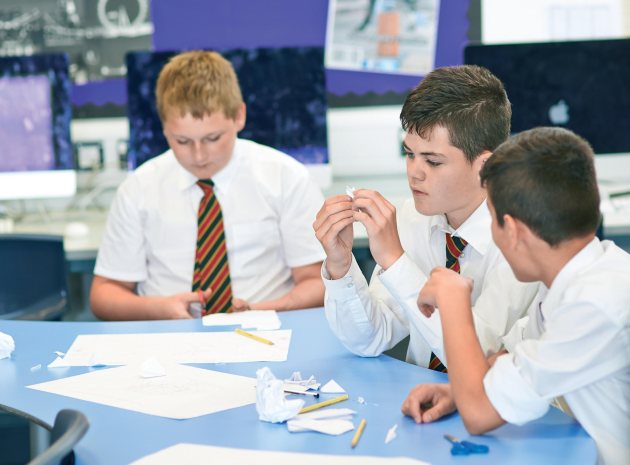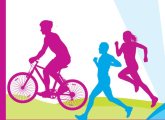Mother Nature knows a thing or two about design – so why not let her inspire your students, asks Zoe Eaves…
During this lesson on biomimetics and design, students will learn how to look closely at nature and extrapolate from the properties of natural objects. It will give learners an opportunity to develop design ideas and encourage innovative thought.
By looking to nature as inspiration for design ideas students will create diverse design solutions. The natural world, which has evolved over millennia, has perfected energy efficient designs, such as the formation of veins in a leaf, the open or closed position of bracts in a pine cone or the shape of sycamore seeds. When teaching, emphasis can be placed on the possibility of designing with minimal energy and without damaging the environment.
The lesson includes links to recently made films from the BBC that feature scientists and the development of biomimetic materials and products. Within the films there are practical classroom activities to extend the lesson into more focused study. Students will feel confident in their ability to be creative and innovative and hopefully have a greater appreciation of the abundance of ideas in the natural world around us.
Resources: Velcro for students to look at the hook and loop inspired by Burdock seeds.
Show your students ‘An introduction into Biomimetics: inspiration from nature’, which can be found at www.bbc.co.uk/programmes/b0520bv9/clips.
They should note any key words or phrases whilst watching the film. Teacher led questions and answers following the clip can aid discussion and clarify meaning for the whole group.
Why Teach This?
Biomimetics is a new and exciting field of research that is referenced in the new D&T National Curriculum. Biomimetics is the study of nature as inspiration for design. It will link students’ knowledge of the natural world to D&T and teach them how to develop creative ideas into innovative designs.
+key resources
The new 2015/16 Design & Technology catalogue from Technology Supplies is now available.
This year’s catalogue is full of everything you need to teach Design & Technology, so you can match inspiring teaching with high quality products; easily ordered from a single provider. And this year you can make your budget stretch even further, as the company has lowered prices on over 2,000 products in its range. You will find even more information and FAQs online at technologysupplies.co.uk/support. Should you wish to discuss your needs with the Customer Support Team, they are happy to help with any enquiry, on 0845 567 0000
Resources: Velcro for students to look at the hook and loop inspired by Burdock seeds.
Show your students ‘An introduction into Biomimetics: inspiration from nature’, which can be found at www.bbc.co.uk/programmes/b0520bv9/clips.
They should note any key words or phrases whilst watching the film. Teacher led questions and answers following the clip can aid discussion and clarify meaning for the whole group.
Resources: a selections of seeds, leaves, shells etc.
Students should be asked to identify the properties of the natural objects supplied by the teacher, such as their shape, function, texture, detail, changing state or unique features.
This could be organised as a group activity where students rotate around the room, annotating on a large sheet with the seed etc placed in the middle. Students write down their immediate observations and challenge themselves to find something new to observe as they move around the room. Alternatively, the same activity could be given to pairs or groups to complete, with a sharing of the information at the end of the activity.
Students will need to deepen their understanding of the properties by explaining why the objects are shaped as they are. Why do they change colour or why do they open and close? The students may have some general knowledge that they could share in a group to help answer these questions. In addition they may need to search for the information using the internet or reference books. This could be organised as small group work with the outcomes presented for the whole group to see.
At this point show a clip with Janine Benyus using the example of the veins in a leaf (www.youtube.com/watch?v=FBUpnG1G4yQ). She describes them as a water distribution system and reflects on the way we design the plumbing in buildings, not with gently branching lines but with right angles. Her description leaves the viewer in no doubt there is a much better way of designing plumbing systems based on the pattern created in nature.
To arrive at a step closer to designing students will need to make a leap from the properties of natural objects to designed objects in our man-made world. This will require a rephrasing of the properties, ideally led by the teacher as a whole group exercise. For example, the veins of the leaf become a ‘water distribution system’, the bracts on a pinecone become an ‘opening and closing device responsive to moisture’, and a dandelion seed becomes ‘an airborne method for carrying and distribution over long distances’.
Students should then begin to work independently. They should choose one example from the group work, eg ‘an airborne method for carrying and distribution over long distances’ and mind map where in our man-made world we need to do the same (for example, food distribution in disaster relief areas).
Students then move on to sketching and annotating their design solution with clear reference to their inspiration from nature.
Home learning
At home students will have more opportunity to observe how insects and wildlife live and could bring their learning into the classroom to share and discuss in the next session.
About the expert
Zoe Eaves teaches at Judgemeadow Community College in Leicester. She is a member of the Design and Technology Association Innovation Group and has worked with them on developing a range of curriculum resources. These include System Reset, a package of D&T teaching resources developed with and published by The Ellen MacArthur Foundation. She has also worked with Practical Action. In 2014 she received the D&*T Association James Dyson Teacher of the Year Award.









